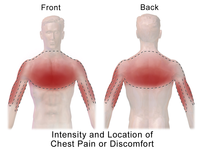
Photo from wikipedia
Aims To establish the safety and efficacy of a rapid one hour chest pain pathway using high sensitivity troponin T (HsTnT) to triage patients presenting with cardiac sounding chest pain… Click to show full abstract
Aims To establish the safety and efficacy of a rapid one hour chest pain pathway using high sensitivity troponin T (HsTnT) to triage patients presenting with cardiac sounding chest pain to Emergency Departments (ED) in the Belfast Health and Social Care Trust (BHSCT). Methods Recent ESC guidelines support the use of HsTnT and a one hour pathway to safely “rule out” myocardial infarction (MI) in patients presenting to the ED with suspected cardiac chest pain. After an initial pilot study the BHSCT implemented a one hour pathway in July 2016 incorporating results of HsTnT levels at presentation and one hour, patient risk assessment and 12 lead ECG. Based on this the pathway triaged patients to a “rule out MI”, “observation” or “rule in MI” group. After introduction follow up data was collected on every patient presenting with chest pain between 1st July 2016 and 30th September 2016 to both ED’s within the BHSCT. Follow up data on final diagnosis, MACE, re-presentation to the ED and mortality was collected for a period of six months. Results Of the 1,454 patients included in the analysis (see figure 1) 594 (41%) were female and the average age was 62. 1,041 (71.6%) patients were triaged to the rule out group and there were no new cardiac diagnoses in this group at 90 days and no cardiac deaths at 6 months. 326 (22.4%) patients were triaged to the “observation” group and there were 4 (1.2%) cardiac deaths in this group at 6 months. Within the observation group a further 42 patients were diagnosed with MI (13% of observation group). 87 (6.0%) patients were triaged to the “rule in” group where 65 (74.7%) had a diagnosis of NSTEMI and 90% had a diagnosis requiring admission under cardiology. There were 6 (6.9%) cardiac deaths in the “rule in” group at 6 months. The negative predictive value for the rule out group was 99.6% and sensitivity 90.1%. The positive predictive value for the rule in group was 84% with a specificity for a cardiac diagnosis of 98.6%. Conclusion Implementation of a one hour troponin pathway in conjunction with clinical assessment is accurate and safe. Using the pathway meant that 77% of patients could be rapidly ruled ‘out’ or ‘in’ using the one hour pathway enabling timely decision making in the ED and safe discharge for 71% patients. In those patients for whom acute MI was ruled out, there were no cardiac deaths after six months follow up. Abstract 26 Figure 1 Triage of patients presenting to ED with suspected cardiac chest pain using one hour algorithm
Journal Title: Heart
Year Published: 2017
Link to full text (if available)
Share on Social Media: Sign Up to like & get
recommendations!